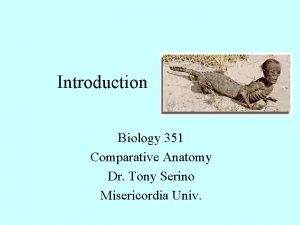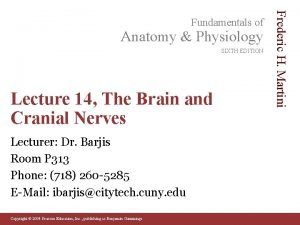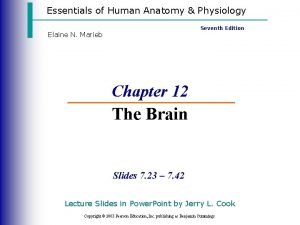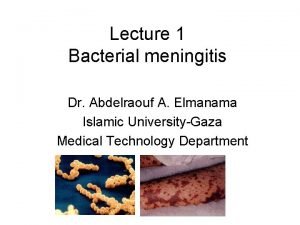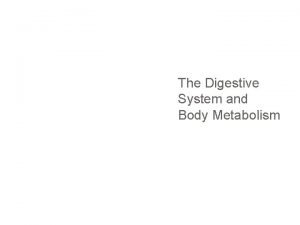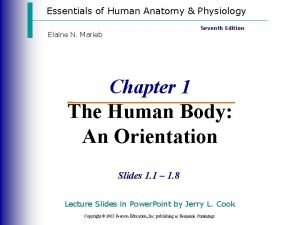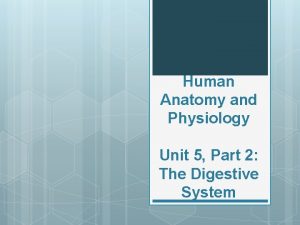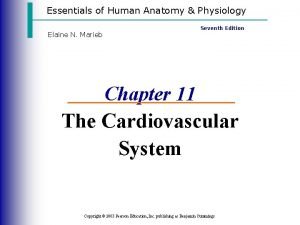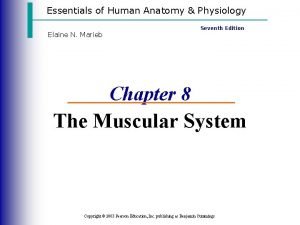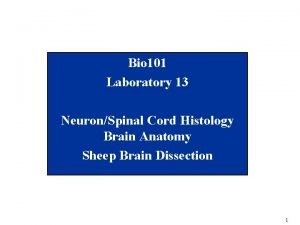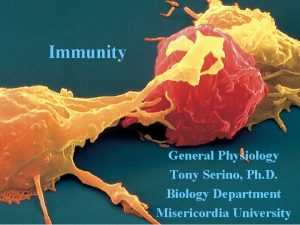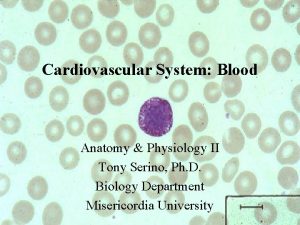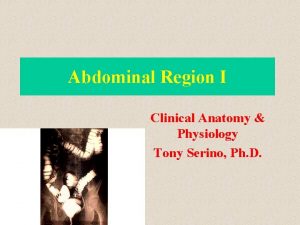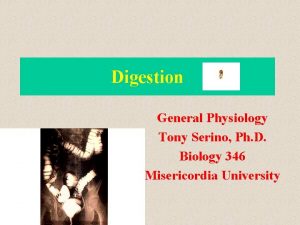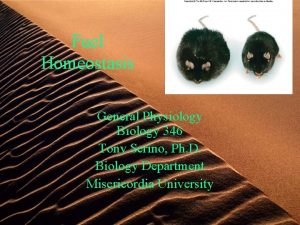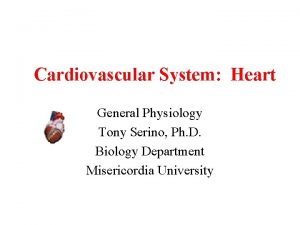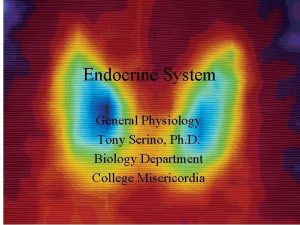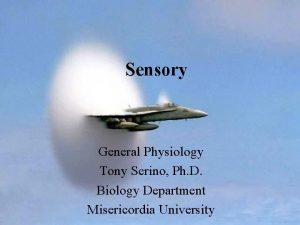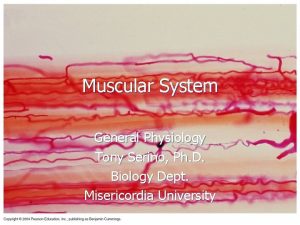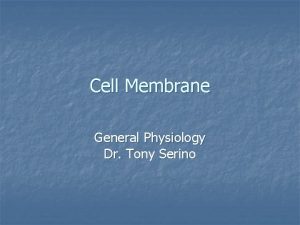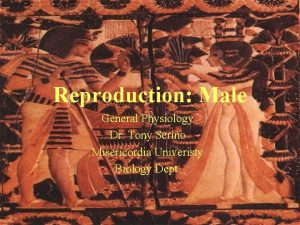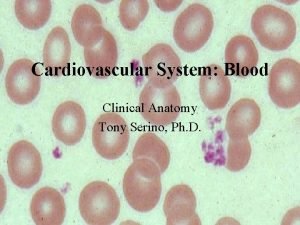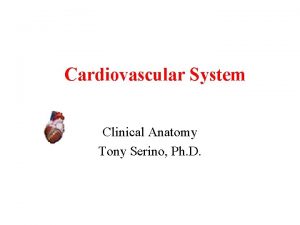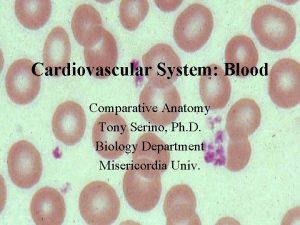Immunity Anatomy Physiology Tony Serino Ph D Immunity











































- Slides: 43

Immunity Anatomy & Physiology Tony Serino, Ph. D.

Immunity: Topic Objectives • Be able to describe the multilevel defenses of the body. • Be able to describe the symptoms and triggers for inflammation. • Be able to define adaptive immunity, antibodies, antigens and haptens. • Be able to explain how haptens can be immunoreactive but not immunogenic. • Be able to explain how T and B cells become immunocompetent and activated. • Be able to identify the different cell types produced in monoclonal expansion of lymphocyte cell lines and their functions. • Be able to identify and explain antibody structure, characteristics of different antibody types and their actions. • Be able to explain how APCs activate lymphocytes. • Be able to explain how vaccines work and how they are made. • Understand the difference between naturally and artificially acquired active and passive immunity

Immune System • Provide defense of the body against infectious agents, toxins, foreign bodies, and cancers • Two types of defenses: – General (Non-specific or Innate) Defense • • Barriers Normal Flora and Fauna Fever Surveillance Inflammation Non-specific Phagocytic WBCs and NK cells Protective Chemicals – Specific (Adaptive) Defense --Lymphocytes

Barriers • Prevent infectious agents from penetrating internal environment – Epithelium ( thickness, tight junctions, keratin) -especially the skin – Cilia and mucus – Watery secretions (tears, saliva) – Acidity (stomach, urine, vaginal secretions) • Normal Flora and Fauna –resident bacteria prevent infectious agents from growing on body surfaces

Surveillance • Number of cells and organs to detect invading agents • Langerhans cells of skin, Mast cells, Dendritic cells, and organs like: Tonsils, GALT cells • Gather antigens and present them to lymphocytes

Fever • Rise in Body Temperature – Inhibits invading cell growth; increase body metabolism to increase defense/repair cell activity – Produced by release of pyrogens from leukocytes – Low grade fever is beneficial in fighting infection, high sustained fever may be life threatening

Inflammation • Allows more blood defenses into damaged areas • Triggered by release of paracrines from damaged tissues (PG), attacking WBCs (cytokines), mast cells (heparin and histamine), and activation of blood protective chemicals (complement and bradykinins) • Increases: – blood flow through vasodilation (hyperemia) – capillary permeability – Both lead to local edema • If prolonged or systemic, can become life threatening

Inflammatory Response

Phagocytic WBC and NK cells • WBCs can distinguish the sugars in mammalian cells and those found on bacteria or other parasites – PMNs, macrophage, and mast cells can injure or destroy cells that do not display normal sugars • NK cells –related to T-cells but attack any cell not displaying MHC I proteins – Kill by secreting perforins and other chemicals

Phagocytosis



Protective Chemicals • Chemicals that aid in destroying or retarding infectious agents – Interferon –cytokine released when cell attacked by virus; warns other cells in area – Lysozyme –antibacterial enzyme present in tears and saliva – Complement –blood proteins which can detect and destroy bacteria

Interferon

Complement MAC –membrane attack complex (C 3 -C 9)

Specific (Adaptive) Immunity • Individual targets are selected for attack by the lymphocytes that can bind that target (antigen) • Antigens (Ag) – any large substance not normally found in the body; these illicit an immune response (immunogenic and immuno-reactive) • Haptens are small molecules that can trigger an immune response only if bound to larger molecules (like: pollen, some cosmetics, detergent fragrances, poison ivy animal dander and drugs); they are immuno-reactive but not immunogenic by themselves

Antigenic Determinants Large macromolecules illicit immune response because they have many sites to which immune molecules will attach; proteins have the most of any molecule

Identifying “Self” from “Non-self” • T-cells migrate to thymus, B-cells remain in bone marrow (the primary lymphoid tissues) • Become immunocompetent -selected for their ability to produce a surface receptor against an antigen and to tolerate self antigens • Those that bind weakly to self-antigens are selected, the others are eliminated • The strongest self-antigens are the MHC proteins • Once competent, the cells are released to move through the blood and aggregate in the secondary lymphoid tissues

Thymic Selection

Movement of Lymphocytes

Cells Involved in Specific Immunity • Lymphocytes (B and T cells) -attack antigen bearing agents either chemically (humoral immunity –the B-cells) or physically (cellular immunity –the T-cells) • T and B-cell activation to an antigen works best when they are presented with the antigen by another cell • APCs (Antigen Presenting Cells) (macrophage, surveillance cells, B-cells, infected cells) display foreign antigenic determinants on their MHC II cell surface proteins to activate the lymphocytes

Memory T cell

B-cell Clonal Expansion

Antibody Structure



Antibody Actions Opsonization – Ag-Ab complex makes ID for phagocytosis easier

Humoral Response

Control of Lymphocyte Response • B-cells can be activated by the antigen alone, but it is more effective if they are presented the antigen by APCs or stimulated by T-helper cells • Activation of T-helper cells stimulates complete lymphocyte response

MHC I –found on all body’s cells except RBCs Surface proteins usually bound to pieces of intracellular proteins, but when infected they present fragments of the infectious agent

MHC II –found on APCs -bound to phagocytized outer coat molecules of immuno-agent

T-cell Types


Helper T-cells

Clonal Selection of T-cell

Cytotoxic T-cell Attack

Primary Immune Response

Vaccine Production

Types of Acquired Immunity

Immediate Allergic Reaction

Hypersensitivity -like in TB test - Some drug allergies where the drug is precipitated and Ag-Ab is being destroyed 4. Cytotoxic hypersensitivity –mediated by antibodies that lead to damage or destruction of cells –like in ABO test and hemolytic fetal diseases

Pathologies: AIDS • AIDS –HIV invades T-helper cells, diminishing effectiveness of immune response; may have as long as 8 year incubation time, 100% fatal

Pathologies • Autoimmune Diseases –Immune system targets naturally occurring compounds of the body (usually sequestered proteins) MS, rheumatoid arthritis, Diabetes mellitus (I), etc. • Cancer –cancers cells spontaneously form during life, but the immune system keeps them in check; failure results in tumors and metastasis
 Difference between acquired immunity and innate immunity
Difference between acquired immunity and innate immunity Evidence from molecular biology
Evidence from molecular biology Istituto comprensivo serino
Istituto comprensivo serino Aohs foundations of anatomy and physiology 1
Aohs foundations of anatomy and physiology 1 Telencephalon
Telencephalon Google.com
Google.com Art labeling activity: figure 14.1 (3 of 3)
Art labeling activity: figure 14.1 (3 of 3) Anatomy and physiology
Anatomy and physiology Anatomy science olympiad
Anatomy science olympiad Chapter 13 anatomy and physiology of pregnancy
Chapter 13 anatomy and physiology of pregnancy Anatomy and physiology vocabulary
Anatomy and physiology vocabulary Http://anatomy and physiology
Http://anatomy and physiology Cranial cephalic
Cranial cephalic Brain anatomy and physiology
Brain anatomy and physiology Medial and lateral
Medial and lateral Anatomy and physiology of meningitis ppt
Anatomy and physiology of meningitis ppt Anatomy and physiology ninth edition
Anatomy and physiology ninth edition Figure 14-1 digestive system
Figure 14-1 digestive system Sheep liver lobes
Sheep liver lobes Gastric emptying ppt
Gastric emptying ppt Uterus perimetrium
Uterus perimetrium Thyroid anatomy
Thyroid anatomy Aohs foundations of anatomy and physiology 1
Aohs foundations of anatomy and physiology 1 Anatomy and physiology
Anatomy and physiology Chapter 6 general anatomy and physiology
Chapter 6 general anatomy and physiology Integumentary system psoriasis
Integumentary system psoriasis Layers of esophagus
Layers of esophagus Anatomy and physiology unit 7 cardiovascular system
Anatomy and physiology unit 7 cardiovascular system Nostrils
Nostrils Anatomy and physiology
Anatomy and physiology Irn.org anatomy and physiology
Irn.org anatomy and physiology The central sulcus divides which two lobes? (figure 14-13)
The central sulcus divides which two lobes? (figure 14-13) Anatomy and physiology
Anatomy and physiology Structure anatomy and physiology in agriculture
Structure anatomy and physiology in agriculture Agriscience unit 26 self evaluation answers
Agriscience unit 26 self evaluation answers Anatomy and physiology
Anatomy and physiology Waistline
Waistline Animal physiology exam 1
Animal physiology exam 1 Anatomy and physiology
Anatomy and physiology The speed at which the body consumes energy
The speed at which the body consumes energy Jeopardy anatomy and physiology game
Jeopardy anatomy and physiology game Anatomy and physiology chapter 1
Anatomy and physiology chapter 1 Anatomy histology
Anatomy histology Epigastric region
Epigastric region

